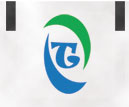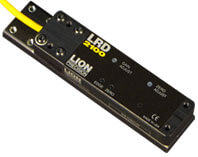Copyright © 2011 Lion Precision. www.lionprecision.com
Summary
The TechNote describes the extra cost associated with label web eye-marks and how new technology makes eye-marks unnecessary.
A Brief History of Clear Labels and Eye-Marks
 Detecting the edge of clear labels is essentially impossible for the inexpensive photo-eyes on many label applicators. In the early 1990s clear labels became very popular because of a wave of clear products such as Crystal Pepsi™ and Miller Clear Beer™. The only way to detect the clear label edges was by printing a black “eye-mark” on the web liner which was used to trigger the photo-eye.
Detecting the edge of clear labels is essentially impossible for the inexpensive photo-eyes on many label applicators. In the early 1990s clear labels became very popular because of a wave of clear products such as Crystal Pepsi™ and Miller Clear Beer™. The only way to detect the clear label edges was by printing a black “eye-mark” on the web liner which was used to trigger the photo-eye.
The traditional label printing process is not designed to print on the back side of the web. Printing the eye-marks required clever reworking of the label printing process and drove the cost of labels up by as much as 20%. Adding eye-marks to clear label webs can still add 5-18% to the label cost.
No Eye-Mark Needed
 Eliminating eye-marks required a new sensing technology that did not require a beam of light. The first capacitive label sensor, the LRD2000 was introduced in 1992. It was a large, two-piece sensor and was quickly replaced by the LRD2100 – the worlds first one-piece clear label sensor. By using an electric field rather than a beam of light, the sensor was unaffected by color or contrast – it measured thickness. The change in thickness at the label edge triggers the sensor. Once the sensor appeared in the market, a University study showed that, in addition to being able to sense clear labels, the sensor was more accurate and much faster than traditional photo-eyes. When metallic inks and foils were added to label designs, materials which affect the performance of the LRD2100, the LRD6110 was introduced which is not affected by metallic artwork. In 2010 the LRD8200 was released using ultrasonic technology making it reliable for virtually all label materials.
Eliminating eye-marks required a new sensing technology that did not require a beam of light. The first capacitive label sensor, the LRD2000 was introduced in 1992. It was a large, two-piece sensor and was quickly replaced by the LRD2100 – the worlds first one-piece clear label sensor. By using an electric field rather than a beam of light, the sensor was unaffected by color or contrast – it measured thickness. The change in thickness at the label edge triggers the sensor. Once the sensor appeared in the market, a University study showed that, in addition to being able to sense clear labels, the sensor was more accurate and much faster than traditional photo-eyes. When metallic inks and foils were added to label designs, materials which affect the performance of the LRD2100, the LRD6110 was introduced which is not affected by metallic artwork. In 2010 the LRD8200 was released using ultrasonic technology making it reliable for virtually all label materials.
Why Are Eye-Marks Still Used?
Although the non-optical LRD sensors from Lion Precision have been around for over a decade, many users still pay for black eye marks to help with the registration of the labels during automatic application. This extra step is unnecessary, costs you money, and may result in other problems during application.
Lion Precision LRD label sensors use changes in web thickness to detect the label edge; they don’t need high contrast colors for a trigger. Some may think they always need an eye mark with clear labels. They don’t realize that even a clear label on a clear liner, with absolutely no artwork at all, can be applied accurately, even at high speed, using these newer technology sensors.
Cost Considerations
New technology label sensors can cost hundreds of dollars more than photo-eyes. This fact may turn many away from using the better sensing technology. But at up to 20% extra for eye-marks, a new sensor can pay for itself in as little as one label order.
Reducing costs, saving money, and increasing margin are all accomplished by buying and using new technology label sensors. If there are rolls of labels arriving on your loading dock with eye-marks printed on them, know that your production costs are higher than they need to be.
Saving Money Easily
Lion Precision LRD label sensors easily fit on existing production lines or can be distributor-installed at the time of the labeler purchase. They work with all labels, including inserts, clear labels, low contrast labels, and regular paper labels, and are used in all industries: pharmaceutical, personal care products, food and beverage, industrial. The value is clear as you will immediately see reduced label costs and improved registration.
Label Sensor Options
| 8200 | 6300 | 2100 | |
|
Application |
|||
| Clear Labels | • | • | • |
| Paper labels | • | • | • |
| Solid foil/metal labels | • | • | |
| Metallic artwork, printing or stamping | • | • | |
| Splices | • | • | • |
| Rewinders | • | • | • |
|
Specifications |
|||
| Response Time | 425 µs | 20 µs | 20 µs |
| Maximum Switching Speed | 1 kHz | 10 kHz | 10 kHz |
| Accuracy | 0.3 mm | 0.4 mm | 0.2 mm |
|
Features |
|||
| Technology | Ultra Sonic |
Cap. | Cap. |
| Adjustments | Button | Button | Screw |
| Bar Graph Display | • | • | |
| Selectable Light/Dark Switching | Button | Button | Wired |
| Wide Fork (3 mm / 0.12″) | • | ||
| NPN and PNP Outputs | • | • | • |
